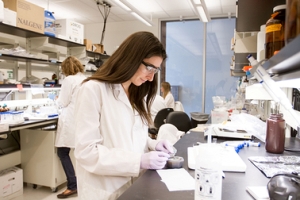Arizona State University researchers will lead a multi-university project to aid industry in understanding and predicting the potential health and environmental risks from nanomaterials.
 Heather Stancl, a doctoral student and graduate research associate in the School of Sustainable Engineering and the Built Environment, conducts nanotechnology-related research in the lab of ASU engineering professor Paul Westerhoff, who will lead a national research network to study the environmental impacts of nanoparticles. Photo by: Jessica Hochreiter/ASU
Heather Stancl, a doctoral student and graduate research associate in the School of Sustainable Engineering and the Built Environment, conducts nanotechnology-related research in the lab of ASU engineering professor Paul Westerhoff, who will lead a national research network to study the environmental impacts of nanoparticles. Photo by: Jessica Hochreiter/ASU
Nanoparticles, which are approximately 1 to 100 nanometers in size, are used in an increasing number of consumer products to provide texture, resiliency and, in some cases, antibacterial protection.
The U.S. Environmental Protection Agency (EPA) has awarded a grant of $5 million over the next four years to support the LCnano Network as part of the Life Cycle of Nanomaterials project, which will focus on helping to ensure the safety of nanomaterials throughout their life cycles – from the manufacture to the use and disposal of the products that contain these engineered materials.
Paul Westerhoff is the LCnano Network director, as well as the associate dean of research for ASU’s Ira A. Fulton Schools of Engineering and a professor in the School of Sustainable Engineering and the Built Environment.
The project will team engineers, chemists, toxicologists and social scientists from ASU, Johns Hopkins, Duke, Carnegie Mellon, Purdue, Yale, Oregon’s state universities, the Colorado School of Mines and the University of Illinois-Chicago.
Engineered nanomaterials of silver, titanium, silica and carbon are among the most commonly used. They are dispersed in common liquids and food products, embedded in the polymers from which many products are made and attached to textiles, including clothing.
Nanomaterials provide clear benefits for many products, Westerhoff says, but there remains “a big knowledge gap” about how, or if, nanomaterials are released from consumer products into the environment as they move through their life cycles, eventually ending up in soils and water systems.
“We hope to help industry make sure that the kinds of products that engineered nanomaterials enable them to create are safe for the environment,” Westerhoff says.
“We will develop molecular-level fundamental theories to ensure the manufacturing processes for these products is safer,” he explains, “and provide databases of measurements of the properties and behavior of nanomaterials before, during and after their use in consumer products.”
Among the bigger questions the LCnano Network will investigate are whether nanomaterials can become toxic through exposure to other materials or the biological environs they come in contact with over the course of their life cycles, Westerhoff says.
The researchers will collaborate with industry – both large and small companies – and government laboratories to find ways of reducing such uncertainties.
Among the objectives is to provide a framework for product design and manufacturing that preserves the commercial value of the products using nanomaterials, but minimizes potentially adverse environmental and health hazards.
In pursuing that goal, the network team will also be developing technologies to better detect and predict potential nanomaterial impacts.
Beyond that, the LCnano Network also plans to increase awareness about efforts to protect public safety as engineered nanomaterials in products become more prevalent.
The grant will enable the project team to develop educational programs, including a museum exhibit about nanomaterials based on the LCnano Network project. The exhibit will be deployed through a partnership with the Arizona Science Center and researchers who have worked with the Nanoscale Informal Science Education Network.
The team also plans to make information about its research progress available on the nanotechnology industry website Nanohub.org.
“We hope to use Nanohub both as an internal virtual networking tool for the research team, and as a portal to post the outcomes and products of our research for public access,” Westerhoff says.
The grant will also support the participation of graduate students in the Science Outside the Lab program, which educates students on how science and engineering research can help shape public policy.
Other ASU faculty members involved in the LCnano Network project are:
- Pierre Herckes, associate professor, Department of Chemistry and Biochemistry, College of Liberal Arts and Sciences
- Kiril Hristovski, associate professor, Department of Engineering, College of Technology and Innovation
- Thomas Seager, associate professor, School of Sustainable Engineering and the Built Environment
- David Guston, professor and director, Consortium for Science, Policy and Outcomes
- Ira Bennett, assistant research professor, Consortium for Science, Policy and Outcomes
- Jameson Wetmore, associate professor, Consortium for Science, Policy and Outcomes, and School of Human Evolution and Social Change